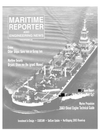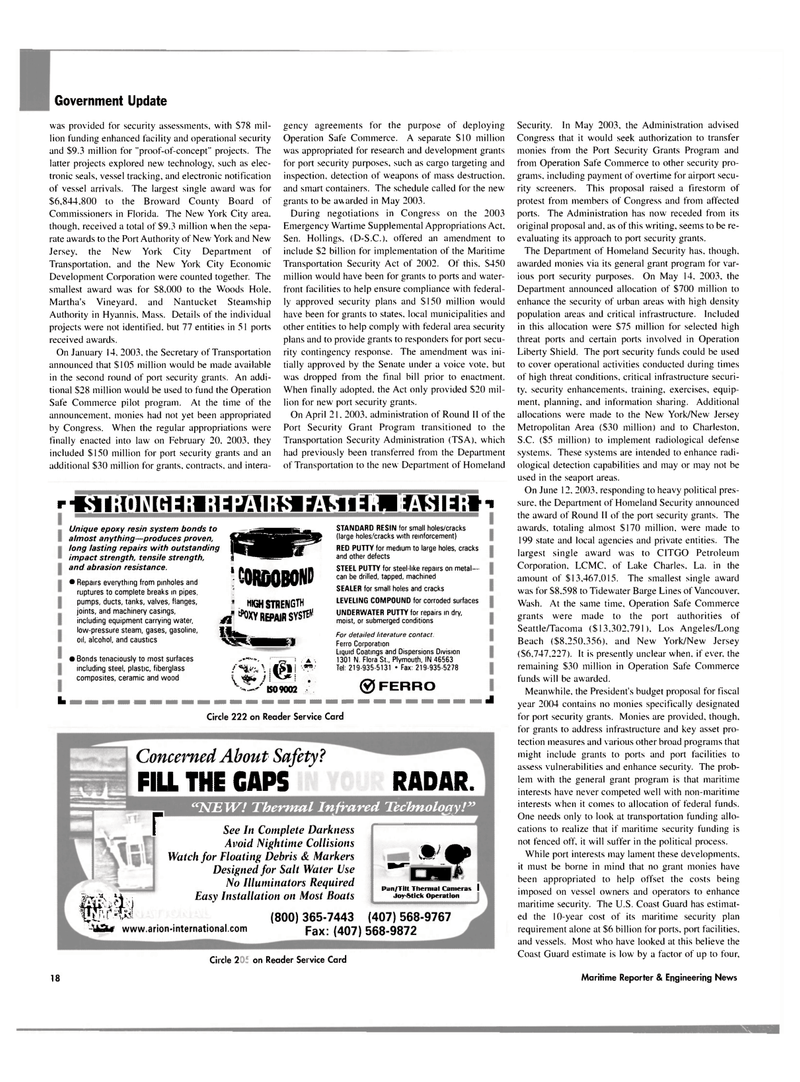
Page 18: of Maritime Reporter Magazine (July 2003)
Read this page in Pdf, Flash or Html5 edition of July 2003 Maritime Reporter Magazine
Government Update was provided for security assessments, with S78 mil- lion funding enhanced facility and operational security and $9.3 million for "proof-of-concept" projects. The latter projects explored new technology, such as elec- tronic seals, vessel tracking, and electronic notification of vessel arrivals. The largest single award was for $6,844,800 to the Broward County Board of
Commissioners in Florida. The New York City area, though, received a total of $9.3 million when the sepa- rate awards to the Port Authority of New York and New
Jersey, the New York City Department of
Transportation, and the New York City Economic
Development Corporation were counted together. The smallest award was for $8,000 to the Woods Hole,
Martha's Vineyard, and Nantucket Steamship
Authority in Hyannis, Mass. Details of the individual projects were not identified, but 77 entities in 51 ports received awards.
On January 14. 2003. the Secretary of Transportation announced that $105 million would be made available in the second round of port security grants. An addi- tional $28 million would be used to fund the Operation
Safe Commerce pilot program. At the time of the announcement, monies had not yet been appropriated by Congress. When the regular appropriations were finally enacted into law on February 20, 2003, they included $150 million for port security grants and an additional $30 million for grants, contracts, and intera- 18 gency agreements for the purpose of deploying
Operation Safe Commerce. A separate $10 million was appropriated for research and development grants for port security purposes, such as cargo targeting and inspection, detection of weapons of mass destruction, and smart containers. The schedule called for the new grants to be awarded in May 2003.
During negotiations in Congress on the 2003
Emergency Wartime Supplemental Appropriations Act.
Sen. Hollings, (D-S.C.), offered an amendment to include $2 billion for implementation of the Maritime
Transportation Security Act of 2002. Of this, $450 million would have been for grants to ports and water- front facilities to help ensure compliance with federal- ly approved security plans and $150 million would have been for grants to states, local municipalities and other entities to help comply with federal area security plans and to provide grants to responders for port secu- rity contingency response. The amendment was ini- tially approved by the Senate under a voice vote, but was dropped from the final bill prior to enactment.
When finally adopted, the Act only provided $20 mil- lion for new port security grants.
On April 21, 2003. administration of Round II of the
Port Security Grant Program transitioned to the
Transportation Security Administration (TSA), which had previously been transferred from the Department of Transportation to the new Department of Homeland
Security. In May 2003, the Administration advised
Congress that it would seek authorization to transfer monies from the Port Security Grants Program and from Operation Safe Commerce to other security pro- grams, including payment of overtime for airport secu- rity screeners. This proposal raised a firestorm of protest from members of Congress and from affected ports. The Administration has now receded from its original proposal and. as of this writing, seems to be re- evaluating its approach to port security grants.
The Department of Homeland Security has, though, awarded monies via its general grant program for var- ious port security purposes. On May 14, 2003, the
Department announced allocation of $700 million to enhance the security of urban areas with high density population areas and critical infrastructure. Included in this allocation were $75 million for selected high threat ports and certain ports involved in Operation
Liberty Shield. The port security funds could be used to cover operational activities conducted during times of high threat conditions, critical infrastructure securi- ty, security enhancements, training, exercises, equip- ment. planning, and information sharing. Additional allocations were made to the New York/New Jersey
Metropolitan Area ($30 million) and to Charleston,
S.C. ($5 million) to implement radiological defense systems. These systems are intended to enhance radi- ological detection capabilities and may or may not be used in the seaport areas.
On June 12. 2003, responding to heavy political pres- sure, the Department of Homeland Security announced the award of Round II of the port security grants. The awards, totaling almost $170 million, were made to 199 state and local agencies and private entities. The largest single award was to CITGO Petroleum
Corporation. LCMC. of Lake Charles, La. in the amount of $13,467,015. The smallest single award was for $8,598 to Tidewater Barge Lines of Vancouver,
Wash. At the same time, Operation Safe Commerce grants were made to the port authorities of
Seattle/Tacoma ($13,302,791), Los Angeles/Long
Beach ($8,250,356), and New York/New Jersey ($6,747,227). It is presently unclear when, if ever, the remaining $30 million in Operation Safe Commerce funds will be awarded.
Meanwhile, the President's budget proposal for fiscal year 2004 contains no monies specifically designated for port security grants. Monies are provided, though, for grants to address infrastructure and key asset pro- tection measures and various other broad programs that might include grants to ports and port facilities to assess vulnerabilities and enhance security. The prob- lem with the general grant program is that maritime interests have never competed well with non-maritime interests when it comes to allocation of federal funds.
One needs only to look at transportation funding allo- cations to realize that if maritime security funding is not fenced off, it will suffer in the political process.
While port interests may lament these developments, it must be borne in mind that no grant monies have been appropriated to help offset the costs being imposed on vessel owners and operators to enhance maritime security. The U.S. Coast Guard has estimat- ed the 10-year cost of its maritime security plan requirement alone at $6 billion for ports, port facilities, and vessels. Most who have looked at this believe the
Coast Guard estimate is low by a factor of up to four.
Maritime Reporter & Engineering News r ^cj | ;{i] fl [fl JJ | fj > 11J i UIJ iHlfc^
Unique epoxy resin system bonds to _ , _ sg^j^ STANDARD RESIN for small holes/cracks almost anything—produces proven, (large holes/cracks with remforcement) long lasting repairs with outstanding ^ RED PUTTY for medium to large holes, cracks impact strength, tensile strength, and other defects and abrasion resistance. Aab*^. AatAnn STEEL PUTTY for steel-like repairs on metal— i.(lllflflDflnll] can be drilled, tapped, machined • Repairs everything from pinholes and *WI1W||VI*V ruptures to complete breaks in pipes, SEALER for smal1 holes and cracks pumps, ducts, tanks, valves, flanges, STRENGTH LEVELING COMPOUND for corroded surfaces joints, and machinery casings, t?0XY RFDAIR SYSTE^ UNDERWATER PUTTY for repairs in dry, including equipment carrying water, ' nfcrAIn 5>3 moist, or submerged conditions low-pressure steam, qases, qasoline, M , , ,, . 7 , . • - For detailed literature contact. oil, alcohol, and caustics Ferro Corporatlon
Liquid Coatings and Dispersions Division • Bonds tenaciously to most surfaces ' i a 1301 N. Flora St., Plymouth, IN 46563 including steel, plastic, fiberglass fSl Tel: 219-935-5131 • Fax: 219-935-5278 composites, ceramic and wood i J Vj* . V 3>B09002 ® FERRO k mm mm mm m mm mm mm wmm mm mm wmi mm mm wmm mm mm wmm mm mm wmm mm mm wmm mm mm mm J
Circle 222 on Reader Service Card
Concerned About Safety?
PILL THE GAPS ! RADAR. r CCNEW! Thermal Infrared Technology!"
P
AkSfas www.arion-international.com
See In Complete Darkness
Avoid Nightime Collisions
Watch for Floating Debris & Markers
Designed for Salt Water Use
No Illuminators Required
Easy Installation on Most Boats * w m0-
E3H>
Pun/Tilt Thermal Cameras 1
Joy-Stick Operation (800) 365-7443 (407) 568-9767
Fax: (407) 568-9872
Circle 246 on Reader Service Card

 17
17

 19
19
